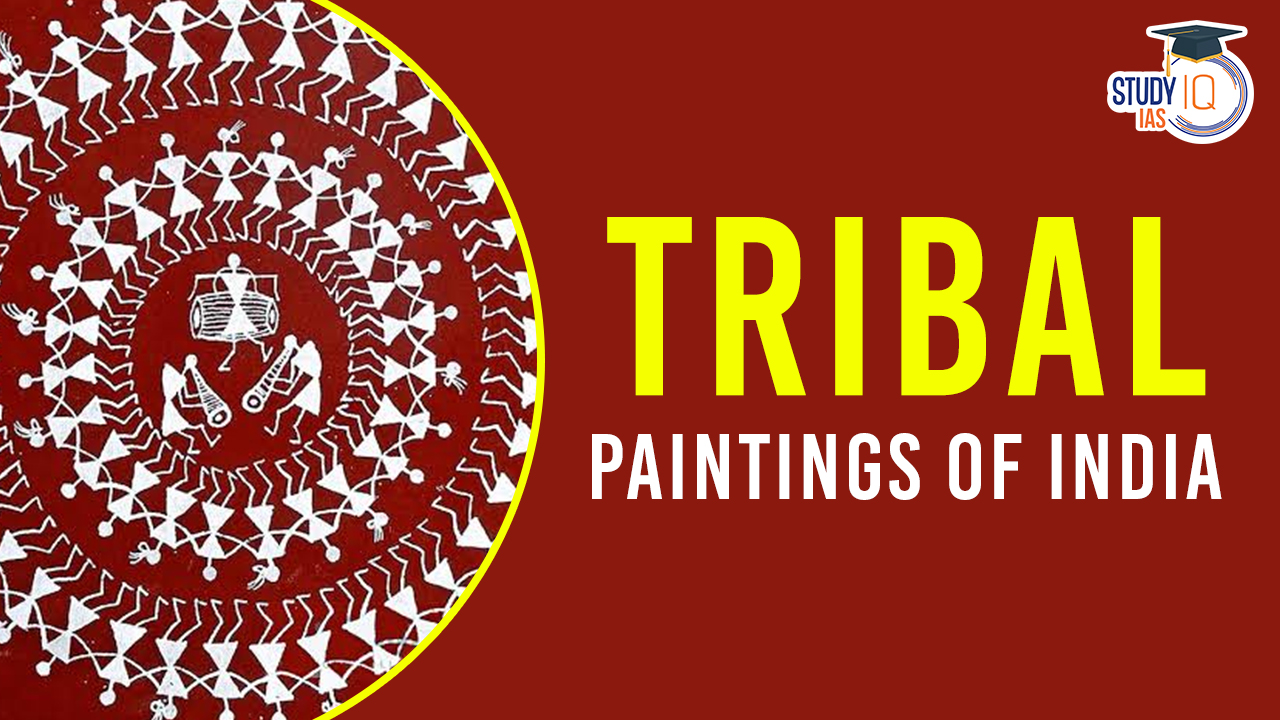Table of Contents
Tribal Paintings of India is a tapestry of diverse expressions. Warli painting, rooted in Maharashtra, captures daily life through simple geometric shapes. Gond art from Madhya Pradesh intricately weaves mythological narratives. Bihar’s Madhubani paintings, rich in bold patterns, depict nature and folklore. Bhil art, vibrant and symbolic, originates in Rajasthan and Madhya Pradesh. Saura paintings from Odisha reflect religious beliefs with bold lines and natural pigments. These tribal artworks not only convey creativity but also safeguard cultural legacies, providing a glimpse into the unique identities of India’s tribal communities.
We’re now on WhatsApp. Click to Join
Tribal Paintings of India
Tribal paintings encapsulate the themes and artisanal skills of artifacts from tribal civilizations, often originating in rural settings. These artworks serve as invaluable tools for archaeologists, offering insights into cultural, religious, and geographical influences on specific groups. They play a crucial role in unraveling the habits, traditions, and lifestyles of these tribes. Indian paintings, with roots tracing back to 30,000 BCE, adorn caves across Central India, providing a historical panorama for studying the rich tapestry of tribal life and expression.
Evolution of Tribal Paintings of India
- Prehistoric Origins: Tribal paintings trace back to ancient times, evident in rock art across Central India.
- Cultural Synthesis: Tribal art evolves through cultural exchanges, assimilating regional traditions and beliefs.
- Colonial Impact: The colonial era introduces new materials and influences, shaping tribal art forms.
- Revival and Recognition: 20th-century sees a resurgence of interest in tribal art, with artists gaining recognition.
- Contemporary Expression: Tribal paintings adapt to contemporary themes while preserving traditional elements.
- Challenges and Preservation: Cultural commodification and socio-economic pressures pose challenges; preservation efforts focus on sustainability.
Famous Tribal Paintings of India
India boasts a rich tapestry of famous tribal paintings, each a vivid expression of cultural identity. Warli paintings, originating from Maharashtra’s Warli tribe, feature geometric simplicity portraying daily life. Gond art, hailing from Madhya Pradesh, captivates with intricate patterns illustrating mythological narratives. The vibrant Bhil art from Rajasthan and Madhya Pradesh celebrates animals and rituals. Saura paintings in Odisha embody religious beliefs through bold lines and natural pigments. Madhubani paintings of Bihar showcase bold patterns narrating mythology and nature. These diverse tribal artworks not only showcase exceptional craftsmanship but also serve as windows into the cultural richness of India’s tribal communities.
Gond Painting
- Practiced by the Gond Tribe: Gond Painting is an artistic tradition rooted in the Central Indian “Gond” tribe, showcasing their unique cultural identity through vibrant and expressive artwork.
- Life as Central Theme: The essence of Gond art revolves around life, with a focus on depicting the beauty of hills, streams, animals, and birds, reflecting the deep connection the Gond tribe has with nature.
- Traditional Canvas: Traditionally, Gond artists adorned the mud walls of their homes with these expressive paintings, turning their living spaces into vibrant canvases that celebrated life.
- Precision in ‘Online Work’: Gond paintings, often referred to as ‘online work,’ are characterized by meticulous attention to detail. Artists carefully draw both inner and outer lines, ensuring precision that immediately captivates the observer.
- Dynamic Lines for Movement: The lines in Gond art are strategically employed to give static images a dynamic quality, creating a sense of movement within the compositions.
- Enhanced Movement with Dots and Dashes: To convey a heightened sense of movement and add depth to the artwork, Gond artists incorporate dots and dashes, enriching the visual narrative.
- Vivid Color Palette: A distinctive feature of Gond art is the use of bright and vivid colors, including white, red, blue, and yellow. These colors contribute to the lively and expressive nature of Gond paintings.
- Natural Materials for Paints: Gond artists use a range of natural materials to create their paints, including charcoal, colored soil, plant sap, leaves, and even cow dung, showcasing their resourcefulness and connection to the environment.
- Unique Color Origins: The vibrant color palette of Gond art has unique origins sourced from the local environment. Yellow from Chui mitti, brown from Gheru mitti, green from leaves, and red from the Hibiscus flower, adding a distinctive touch to each creation.
- Cultural Preservation: Gond art not only serves as a form of creative expression but also plays a crucial role in preserving the cultural traditions of the Gond tribe, encapsulating their worldview and spiritual connection with the natural world.
Madhubani Painting
- Origins in Maithili Village, Bihar: Madhubani paintings trace their roots to the Bihar village of Maithili, where this traditional art form has flourished for generations.
- Diverse Tools for Creation: Artists employ a variety of tools such as twigs, nibs, matchsticks, and even fingers to craft intricate designs and patterns in Madhubani paintings.
- Natural Dyes and Pigments: The vibrant colors in Madhubani paintings come from natural dyes and pigments, emphasizing the connection between the art and the earth.
- Geometric Patterns and Brilliant Colors: Prominent features include striking geometrical patterns and line drawings filled with brilliant colors, creating visually captivating compositions.
- Expression on Village Walls: Initially, women in the village expressed their thoughts, hopes, and ideals by painting these murals on their home walls, reflecting the personal and cultural significance of Madhubani art.
- Evolution into Celebrations: Over time, Madhubani paintings transcended domestic spaces and found a place in celebrations and special occasions, becoming a cultural symbol beyond the confines of the home.
- Themes: Hindu Legendary Characters: Madhubani paintings often depict Hindu legendary characters, including Krishna, Rama, Lakshmi, Shiva, Durga, and Saraswati, offering a visual narrative of their lives and stories.
- Distinct Styles: Various styles within Madhubani painting contribute to its diversity. Godna, Kohbar, Tantrik, Bharani, and Katchni showcase unique approaches, adding depth to this art form.
- Flat Application of Colors: Colors are applied flatly, with no shading and no white space, contributing to the distinct appearance of Madhubani paintings. Dark and brilliant colors, such as lampblack and ochre, dominate the palette.
- Modern Adaptations: While traditional tools and techniques persist, modern Madhubani artists also use brushes, nib pens, and synthetic colors, showcasing the adaptability of this age-old art form.
Warli Painting
Warli folk art, deeply rooted in the Northern Sahyadri region of Maharashtra, has its origins among the Warli tribes, known for their steadfast preservation of traditional practices and rejection of modern culture.
Focus on Natural Elements: The heart of Warli paintings lies in their devotion to natural elements. Unlike other art forms, Warli paintings abstain from depicting legendary stories, instead drawing inspiration from the world around them.
Traditional Technique: Executed with a mixture of rice paste, gum, and water, Warli paintings are brought to life using bamboo stick brushes. This time-honored technique reflects the tribe’s connection to their environment.
Evolution of Participation: Initially, Warli women, known as Savasini, exclusively practiced this art. Over time, a shift occurred, and men also became active participants, contributing to the rich tapestry of Warli art.
‘Chawk’: Depicting Daily Life: One of the standout Warli paintings is ‘Chawk,’ portraying married women embellishing their kitchen walls with white. This piece encapsulates the daily rituals and domestic life of the Warli tribes.
Goddess Palaghat at the Center: Central to many Warli paintings is the depiction of Goddess Palaghat, a fertility deity, positioned in the center of a rectangular space. The surrounding artwork includes trees, daily chores, dancers, women’s tools, and animals.
Reflection of Tribal Existence: Warli art serves as a visual narrative of the basic existence of the Warli tribes, offering glimpses into their daily lives, rituals, and reverence for nature.
Cyclical Time in Art: Warli paintings often suggest a belief in the cyclical nature of time, evident in their spherical compositions. This adds a philosophical depth to their artistic expressions.
Celebration of Life: The joy, dance, and festivities depicted in Warli dancer paintings reveal the tribe’s celebration of life. These artworks become a vibrant testament to the vitality of the Warli community.
Harmony with Nature: The intricate designs of flora, wildlife, and festivals in Warli art underscore the tribe’s profound connection with nature. This harmony evokes a sense of prehistoric paintings, resonating with a rhythmic quality.
From Tradition to Modernity: Warli art has transcended tribal boundaries, finding its way onto paper and fabric. Widely reproduced and sold throughout the country, it preserves the cultural heritage of the Warli tribes in a modern context.
Rajasthani Miniature Paintings
The inception of Rajasthani Miniature Paintings in India is attributed to the Mughals, marking a significant cultural influence on artistic traditions.
Artistic Precision: Rajasthani Miniature Paintings are meticulously crafted, with an unwavering attention to detail. Every element, from lines to intricate particulars, is skillfully executed, creating a visually stunning and harmonious pattern.
Vibrant Hues and Patterns: These artistic creations are distinguished by their vibrant hues, forming captivating patterns that add vibrancy and life to the miniatures. The use of color is deliberate and contributes to the overall aesthetic appeal.
Diverse Mediums: Modern artists adeptly produce Rajasthani Miniature Paintings on various mediums, including silk, ivory, cotton, and paper. This versatility allows for a rich expression of creativity and ensures the continuation of this traditional art form.
Continued Artistic Tradition: The legacy of Rajasthani Miniature Paintings endures through contemporary artists who skillfully carry forward this rich tradition. The miniatures serve as a canvas for storytelling and cultural expression, embodying the historical blend of Mughal and Indian artistic influences.
Pattachitra
- Meaning and Origin: The term “Pattachitra” translates to “image on a cloth” in Sanskrit. This traditional art form has its roots in the state of Odisha, where it is intricately practiced.
- Themes Reflecting Tradition: Pattachitra art captures themes rooted in Hindu mythology, religious stories, folklore, and deity figures. Artists use natural paints on fabric canvases to depict simple yet profound narratives.
- Connection to Shri Jagannath’s Religion: Pattachitra is directly linked to the religious traditions of Shri Jagannath and the iconic temple in Puri. Its origins are believed to date back to the 12th century, forming an integral part of the cultural tapestry.
- Representative Themes:
- Thia Badhia: Depicting Lord Jagannath’s temple, this theme holds a special place in Pattachitra, symbolizing devotion and spirituality.
- Krishna Lila: Dramatizing Jagannath as Lord Krishna, showcasing his divine powers during childhood.
- Structured Art with Guidelines: Pattachitra follows a structured approach with specific guidelines and limitations. Natural materials are predominantly used in this art form, contributing to its authenticity.
- Dasabatara Patti and Panchamukhi:
- Dasabatara Patti: Illustrating Lord Vishnu’s ten incarnations, reflecting the rich mythological heritage.
- Panchamukhi: Depicting Lord Ganesh as a five-headed deity, showcasing the diversity of divine manifestations.
- Natural Materials and Floral Borders: The materials used in Pattachitra are mostly natural, and paintings are adorned with a mandatory floral border. This adherence to natural hues adds authenticity and cultural richness to the artwork.
- Profile Portrayals and Elongated Eyes: Pattachitra paintings predominantly feature profile portrayals, with a distinctive style of elongated eyes. This artistic choice contributes to the unique visual appeal of the artwork.
- Emotional Expressions through Hues: Pattachitra paintings convey intense emotional expressions with remarkable clarity, owing to the prominent use of solid and vivid hues. This deliberate choice of colors adds depth and resonance to the storytelling.
Kalamezhuthu
Artistic Resemblance: Kalamezhuthu, akin to rangoli or kolam, is an intricate drawing traditionally crafted at the entrances of temples and homes, adding a touch of sacred artistry to these spaces.
Origin in Kerala: The origins of Kalamezhuthu can be traced back to the vibrant Indian state of Kerala, where this unique art form has flourished as a significant cultural expression.
Sacred Depictions: This art form involves the creation of elaborate drawings depicting gods, often found on the flooring and woodlands of temple sanctuaries. It serves as a visual representation of devotion and reverence.
Precision and Standards: The creation of Kalamezhuthu involves meticulous attention to detail, precise measurements, and careful choices in shading. Each painting adheres to strict standards, ensuring the accuracy and sanctity of the artistic representation.
Pithora Painting
- Cultural Practices in Central Gujarat: Pithora Painting is a deeply ingrained ritualistic art form practiced by tribes in Central Gujarat, including the Rathwas and Bhilalas, reflecting the cultural richness of the region.
- Distinct Wall Artwork with Symbolism: Central to Pithora Painting is the depiction of seven horses, believed to symbolize the seven hills encircling the Gujarat-Madhya Pradesh border. This unique wall artwork is renowned for its symbolic representation.
- Origin and Deity Connection: The name ‘Pithora painting’ draws its roots from the tribal god, God Pithora (Pithora Baba), underscoring the spiritual and divine significance of this artistic tradition.
- Role of Lakhara Artists: Lakhara artists, well-trained in the intricacies of Pithora art, play a pivotal role in its development. They are responsible for bringing the ritualistic wall murals to life.
- Auspicious Rituals and Blessings: Pithora paintings are crafted by Lakharas during auspicious rituals, and the belief is that by adorning their walls with these artworks, the tribes seek blessings and divine favor from God Pithora.
- Creation Process in Roofed Galleries: The creation of Pithora Art takes place in the roofed galleries, or Verandahs, of the houses. Before commencing the painting, the walls are meticulously prepared with a mixture of cow dung and soil, setting the canvas for the sacred artwork.
- Preparation by Unmarried Girls: Unmarried girls are traditionally entrusted with the responsibility of preparing the walls for Pithora art, showcasing the community’s commitment to passing down the cultural legacy.
- Vibrant Color Palette: Pithora paintings are characterized by a vibrant color palette featuring white (Clay), orange, green, blue, red, and yellow. These colors bring life to the depictions and infuse energy into the storytelling.
- Bordered Rectangular Spaces: The paintings are typically bordered within rectangular spaces, providing a structured and visually appealing framework for portraying mythological or cherished events in the lives of the Rathwas.
Palam Qalam Painting
Subject Matter: Palam Qalam Painting is centered around depicting the daily life scenes of ordinary people, offering a glimpse into the routines and activities of the common folk.
Scale of Artwork: These artworks, true to their name, are indeed small masterpieces, showcasing intricate details and storytelling within a compact frame.
Artistic Dominance: Male artists predominantly contribute to the creation of Palam Qalam Paintings, adding their unique perspectives to the portrayal of everyday life.
Indo-British Influence: The style of Palam Qalam Painting bears the influence of both Indian and British artistic traditions, reflecting a nuanced fusion of cultural elements.
Renowned Artist: One of the notable painters in the realm of Palam Qalam is Sevakram, recognized for his skill in crafting these artworks and contributing to the evolution of this distinct style.
Bazar Painting
Cultural Origin: Bazar paintings, synonymous with Bengali paintings, find their roots in 19th-century West Bengal, showcasing a distinctive blend of regional artistic traditions.
European Influence: Infused with a European touch, Bazar paintings draw inspiration from Roman and Greek figures. This unique style reflects the impact of European aesthetics on the artistic landscape of West Bengal.
Divergence from Traditional Iconography: Bazar paintings deviate from traditional Indian iconography, particularly in their rejection of depicting Indian gods with multiple arms. This departure is influenced by a preference for human-like representations over divine imagery.
Theme of Everyday Scenes: The thematic focus of Bazar paintings revolves around everyday bazaar scenes, providing a vivid portrayal of the bustling marketplace. Additionally, these artworks often depict female dancers captivatingly performing before British officers, capturing a moment in cultural exchange.
Tribal paintings in India UPSC
Tribal paintings in India, such as Warli from Maharashtra, Gond from Madhya Pradesh, and Madhubani from Bihar, reflect diverse cultural identities. Originating from prehistoric rock art, these artworks evolve through cultural exchanges, colonial influences, and contemporary adaptations. Notable examples include Gond art’s vibrant depictions of nature, Madhubani’s bold patterns narrating mythology, and Warli’s geometric simplicity portraying daily life. These paintings serve as vital archaeological tools, preserving tribal legacies. Challenges include cultural commodification, but preservation efforts focus on sustainability. Each style, from Warli to Madhubani, contributes to India’s rich tapestry, showcasing the evolution and resilience of tribal art.


 Chittorgarh Fort: Mining Ban within 10 k...
Chittorgarh Fort: Mining Ban within 10 k...
 PM Modi visits Wat Pho Temple in Bangkok
PM Modi visits Wat Pho Temple in Bangkok
 Mahabodhi Temple Complex at Bodh Gaya
Mahabodhi Temple Complex at Bodh Gaya





















